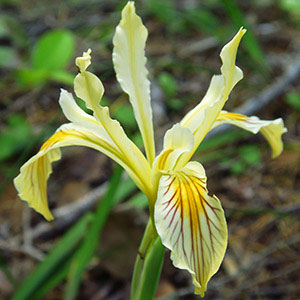Iris fernaldii
Iris bracteata
Fernald's iris
Siskiyou iris
many-branched, producing dense clumps, compact, slender, ca. 0.6 cm diam., base covered with remains of old leaves;
roots fibrous.
sheathed with old leaf bases, slender, 0.6–0.9 cm diam.;
roots few, fibrous.
simple, solid, 2–4 dm.
simple, solid, 1.5–3 dm.
basal with blade gray-green, usually brilliantly colored basally, drying to unusual gray-green, veins fairly prominent, to 4 dm × 0.7–0.8 cm, often quite glaucous, margins not thickened;
cauline 2–several, spreading, sheathing stem for about 1/2 length, foliaceous, blade not inflated.
basal with abaxial surface of blades deep glossy green on one side of fan, light yellow-green on other side, pink or red-tinged basally, strongly ribbed, 4–6 dm × 0.8–1 cm, rigid, margins not thickened;
cauline 3–6, imbricated, closely sheathing stem ca. 2/3 length, spreading distally, bractlike, blade inflated, often shorter than basal leaves.
2-flowered;
spathes opposite, connivent, often flushed red basally, broadly lanceolate, 5–9 cm × 6–11 mm, subequal.
simple, units 1–2-flowered;
spathes closed tightly around pedicel and ovary, lanceolate, 5.2–9 cm × 6–8 mm, subequal, herbaceous, margins scarious, apex acuminate.
perianth pale creamy yellow with gold or gray veins;
floral tube funnelform, 3–6.2 cm, spreading apically to form wide throat;
sepals horizontally spreading, claw with deep yellow median line, oblanceolate to spatulate, 4.5–7 × 1–2 cm, base gradually attenuate into broad claw;
petals narrowly oblanceolate, 4.3–6 × 0.6–1.4 cm, base gradually attenuate into narrow claw;
ovary elliptical, nearly circular in cross section, 1.5–2.3 cm;
style 2.2–3 cm, crests divergent, linear to narrowly oblong, 1–1.7 cm;
stigmas triangular, margins entire;
pedicel 0.9–2.2 cm at anthesis.
perianth cream to buff-yellow;
floral tube 0.8–0.9 cm;
sepals with deeper yellow signal, veined with purple or brown, obovate-lanceolate, 6.5 × 2.5 cm, base gradually attenuate into wide claw;
petals narrowly oblanceolate, 7–9 × 0.8–2 cm, base gradually attenuate;
ovary nearly circular in cross section, 1.5–2.5 cm, base gradually attenuate into pedicel, apex abruptly acuminate into floral tube;
style 2.2–3 cm, crests spreading, yellow, not veined, 1.2 × 0.9–1.7 cm, margins toothed;
stigmas triangular or tongue-shaped, margins entire;
pedicel 3–6.2 cm.
oblong, roundly trigonal, distinctly beaked, 2.5–3.5 cm.
nearly circular in cross section, tapering abruptly at each end, 2–2.5 × 1–1.5 cm.
dark brown, wrinkled.
dark brown, irregular in shape, wrinkled.
= 40.
= 40.
Iris fernaldii
Iris bracteata
Iris fernaldii hybridizes with I. douglasiana, I. innominata, and I. macrosiphon.
(Discussion copyrighted by Flora of North America; reprinted with permission.)
Iris bracteata is limited to one county each in northern California and southern Oregon. It hybridizes with I. chrysophylla, I. douglasiana, I. innominata, I. munzii, I. purdyi, and I. tenax.
(Discussion copyrighted by Flora of North America; reprinted with permission.)


